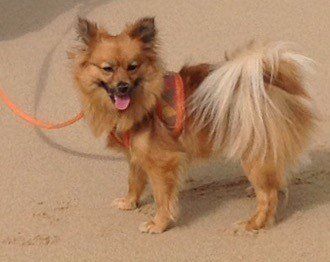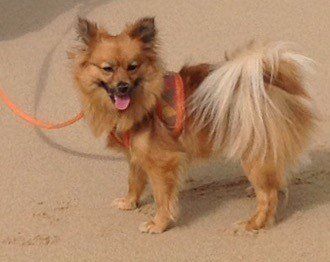Harness - Collar
PetPom

The
Pomeranian
Information
Center
Choosing a Harness and Collar for a Pomeranian
Overview
Choosing the right collar and harness for your Pomeranian is very important for the elements of comfort, safety, and health.
If you're wondering if you should have a collar or a harness and which one is better, the answer is that you will want to have both.
And if you only had to choose one, you'd want a harness.
Every time that you take your Pomeranian out on leash, the method in which you do so can either be risky, or can help prevent injury commonly seen with toy breed dogs.
Why Not Justa Collar?
Why Not Just a Collar?
Here are a few key points to know:
1) The anatomy of a Pomeranian's neck makes him vulnerable to injury.
It is important to understand the anatomy of the neck area. Because, after all, that is where a collar sits.
A dog's trachea (also known as windpipe) is the tube through which air passes in and out, and this is surrounded by rings of cartilage.
Surrounding that are muscles. Small toy breeds like the Pomeranian do not have a lot of muscle built up around the neck and shoulders.
In addition, the Pomeranian breed is prone to degenerative weakness of the tracheal rings.
These factors can result in a particular neck injury known as collapsed trachea.
Collapsed trachea is a condition in which the tracheal rings collapsed inward.
2) A collar increases the risk of injury. While collapsed trachea is mainly considered to be a genetic issue, and can happen regardless of whether you use a collar or harness, the use of a collar can increase the risk of this.
This is because it may be triggered by an event such as a jerk to the neck area, or long-term pressure can cause a wearing down.
Whether or not there is a genetic weakness, the rings surrounding the windpipe are prone to injury.
3) This injury can be devastating. When one or more of the rings breaks inward, this obstructs breathing and can cause a dog to endure dog quite a bit of pain. It can cause massive coughing fits that trigger additional damage to the area. There is often a characteristic honking cough, and internal swelling.
Typically heavy doses of a variety of medications including anti-histamines, anti-inflammatory meds, and antibiotics are given to help control this. Part of the treatment is to immediately stop wearing a collar, and to switch to a harness. For severe cases, surgery will be needed to stabilize the windpipe.
4) Even 'innocent' walking on leash and collar can cause issues.
You may assume that if your Pom walks nicely beside you that there won't be any problems. However, can you guarantee that there will never be any pressure on his neck with the use of a collar?
Both acute events (lunging off to the side, the leash is stepped on and causes a quick jerk to the neck, etc.) and long-term events (years of pressure, strain, and tension on the neck due to pushing ahead while on leash, or for some tiny Poms, just the weight of the leash on the neck) are both areas of concern.
5) A harness is a must when a Pomeranian is in the car.
Hopefully, you are using a properly sized booster car seat for your Pomeranian
to keep him safe while driving him.
Within the seat is a connector strap. That is meant to be clipped to a dog's harness. Not his collar. Connecting it to a collar could be catastrophic in the case of a car accident.
Since the goal of the car seat is to prevent injury or death, using a seat along with a collar is illogical and dangerous.
Why Harnesses Are the Best Choice
A properly fitting harness is the best method to keep your Pomeranian safe while on leash. It does not touch the neck at all. Harnesses run along the chest, shoulders and back.
Whenever there is any tension in the leash, pressure is distributed across these areas of the body which are much sturdier (with bones, not just cartilage) and can take the dispersed force.
In addition, if you ever bring your Pom into the car with you, it is a necessity.
(continued below)
-min-250x335-532w.jpg)
Paris 4 months old, photo courtesy of Tonia Johnson
In addition, not only does a good one keep a Pomeranian safe in this way, it also gives an owner better control whenever the dog is on leash.
If you have your Pom on a harness, you can keep him right by your side, hold him back from jumping, or even quickly reel him to you in cases of perceived danger, all without putting stress on his neck and possibly causing injury.

Lulu, at 3 years old, photo courtesy of Lynn
Common QuestionsAbout Harnesses
Common Questions About Harnesses
Do I need a collar and a harness?
It depends on how you prefer to do things. In most cases, you will want a lightweight collar for ID purposes. That will be worn at all times. Then, the harness will be put on for walks.
If I use just a harness on my Pomeranian, where do the ID tags go?
If you opt to have your Pom collar-free (and on harness for walks), the ID tag can often be slipped on the D-ring of the harness (where the leash attaches).
Aren't harnesses a hassle?
Not really. There are some great options that are 'easy on, easy off'.
There are some with easy-release buckles, and even some that attach via a velcro piece. So putting one on and off your Pom can be done within seconds and without much fuss.
Will a harness ruin the coat? Or make it flat?
A quality harness that is made of quality materials will not cause any issues at all for the coat. Nicely made harnesses are designed to be breathable. The only issue that might occur would be some static if there is friction between the harness and the fur.
For this, we recommend always using your chosen leave-in spray (which you should already be using regularly to prevent sun & cold damage, split ends, and other other elements that can cause the skin and coat to become dry) giving the coat a light spritz before placing the harness on.
We really like Chris Christensen Ice on Ice Leave-in Conditioner with Sunscreen , which contains a sun screen to guard a Pomeranian's coat from the effects of the strong summer sun, is lightweight so that it does not weigh the fur down, and also smells nice.
, which contains a sun screen to guard a Pomeranian's coat from the effects of the strong summer sun, is lightweight so that it does not weigh the fur down, and also smells nice.
Another great leave-in spritz is The Stuff Leave-in Conditioner & Detangler Spritz, which smells really nice, adds a great texture, and protects the coat very effectively.
In regard to the fur laying flat; the fur will indeed be flattened a bit while the harness is on; as you'll see from the photos on this page it can create a cute 'puffed' look for some Poms.
This is just temporary; as soon as the harness is removed, the coat will spring right back. Fur cannot be altered from wearing a harness or any sort of clothing.
Depending on if a Pom has a trimmed layered coat or one left to grow very long, you may want to brush the fut a bit with a pin brush once the harness is taken off.
How to Choose the Best Harness for Your Pom
Have you given up trying to put a harness on your Pom? Or have you not even tried because you 'know' that your dog will hate it?
If so, chances are that you all need is the RIGHT harness for your Pom to willingly accept wearing it and for you to not have struggles with putting it on.
Here are some key elements:
1) The #1 thing is fit. The Pomeranian is a small dog, and has a relatively wide chest. Since many Pomeranians are between 3 and 9 lbs. (though the standard range is 3-7), you'll need a harness that is small enough to fit a tiny frame, but allows room around the forechest.
Luckily, there are some great brands that can be found in extra-extra-small, and extra-small.


Evie, at 18 months old
Photo courtesy of Anne Johnson
2) Material.
You'll want a breathable material. Some of our favorite harnesses are made of polyester air mesh, which is light-weight, allows for great air flow, and is very soft to the touch.
3) Easy on/off.
Look for a harness that has adjustable straps or adjustable velcro wrap, and either closes via that velcro, or has quick release buckles. These elements will make putting this on your Pom pretty easy, and removable will be just as fast.
There are 3 main types of harnesses:
Strap harness
- These work very well for many dog breeds; however, most of these types cannot be found in small enough sizes for a Pomeranian.
Wrap harness
- These are a great choice. These are tiny wrap vests; there will be a D-ring between the shoulder blades for the leash to attach. With these, there are some better ones that are sized for Poms, and also made of superior fabric and quality to offer comfort and structure.
Clothing harnesses
- This is a vest, jacket, or other outerwear that has a D-ring sewn into the back for leash attachment. These can be a good choice if you want your Pom to have an extra layer for warmth, while sticking with the harness method.
Recommended Harnesses
Generally, harnesses are sized by neck and chest size. We recommend going by your Pom's neck size. A neck size of 6 to 8" generally is good for Pomeranians under 5 lbs. And a neck size of 8 to 10" typically fits dogs 5 to 10 lbs.
If you opt for an adjustable harness, you will be able to adjust the neck, chest, or both and this can ensure a perfect fit.
With one of our favorites for Pomeranian puppies and adults on the smaller end, the Lil Pals Mesh Comfort Adjustable Harness for Puppies and Toy Breeds , has a petite extra-small that fits tiny Poms 5 lbs. and under. And their petite small is great for Poms 5 to 7 lbs.
, has a petite extra-small that fits tiny Poms 5 lbs. and under. And their petite small is great for Poms 5 to 7 lbs.
And another of our favorites, the PUPPIA International Harness Soft B Vest comes in extra small. Depending on the exact design that you opt for, that will be for either a neck girth of 7.5 or 8.5", which is applicable for most Pomeranians.
Choosing the Proper Collar
If you have a good harness for your Pomeranian, you do not necessarily need a collar; however it is recommended. And the reason for this is just to stay extra safe in regard to the slight possibility that your Pom may dart out of the house and run off. Will this happen? Probably not. However, why take the risk?
Dogs can run away for a variety of reasons. One of the most common is that un-altered dogs run off to find a mate; it's canine instinct. With un-neutered males, it can be a near constant urge, and with un-spayed females, that desire will only happen around the time of the heat cycle.
But, even for reasons such as curiosity or just getting startled, a dog may dash out of the house when the door is open; they can be exceedingly quick and not easily stopped.
And though you Pom may love his harness, think of it as clothing, and not want you to take it off, it will typically only be used for walks.
So, at all other times, it's a good idea to have a lightweight collar for your Pom to hold his ID tags. That way, if he is every lost, your odds of getting him back are greatly increased.
Here what you will want to look for:
1) Material -
The best collar for a Pomeranian puppy
or dog will be a lightweight, waterproof material. While chains made of various metals can be cute (depending on their design) most will be too heavy for this small toy sized dog.
If it is not water resistant or water repellent, the collar may hold in moisture (from conditioner sprays, wet fur after baths, rain sprinkles, etc.) and could become smelly and create a breeding ground for bacteria between the collar and the fur.
Jeweled and decorated collars can be cute and as long as they are not heavy, these are just fine. The only thing you'll want to check is that the decorations are secure and cannot fall off, as they could then be mouthed and swallowed.
2) Width and Thickness -
When a collar is too narrow and thin, it can cut into a Pom's neck area, causing discomfort. Alternatively, if it is too wide or too thick, it can impede mobility; a dog can have trouble turning his head, dropping his head down to eat and drink, etc.
3) Proper Adjustability -
When you have a collar that only has segmented sections in which to choose for making it tighter or looser, you may find that none of the settings fit your particular Pomeranian.
The best type of collar for a Pom will have a sliding size adjuster that you can tailor to your puppy or dog's exact needs.
4) ID holder - There are two main types of collars in regard to how ID tags are held. Some have embroidered ID information or embedded brackets, which is a great all-in-one idea. The other is the more traditional collar and loop for ID attachment.
5) Quick snap or quick release
- Be sure that the collar has a snap/click buckle to allow it to be removed in an instant, if necessary. Do not use a design that resembles a belt.
The Right Fit for a Pomeranian's Collar
The collar should be adjusted so that you can slip TWO fingers underneath it and easily spin it; but not so loose that it could snag on anything or slip off.
When to Take the Collar Off
In order to properly groom your Pom, you will want to remove the collar every time that you brush the coat unless you're doing a quick touch-up. This will allow you to make nice, long sweeping strokes from the crown and down the back to pick up shedded hairs without having it in the way.
You'll also want to remove the collar for baths so that you can completely cleanse and condition the entire coat. Once your Pom is completely dry, it can be put back on.
You may also like:
Choosing the right bed for a Pomeranian
- A really good bed can make a huge difference, particularly if a Pom spends some time home by himself.
Does a Pom need a playpen? See how having the right sized indoor canine playpen can make a world of difference with your Pom.
How to housebreaking a Pomeranian puppy
- When you have a good plan, and follow through on what needs to be done, training can be complete in as little as 2 months.
Super helpful guidelines, for fast success.
If you email photos to us, you agree that PetPom is given free copyright to use at our discretion. We will always credit the photo to the name of the Pom's owner(s) if it is supplied.
Email: Contact@PetPom.com
All text, images and artwork protected by US and International copyright laws. All rights reserved. Copyright PetPom.com
We are a participant in the Amazon Services LLC Associates Program, an affiliate advertising program designed to provide a means for us to earn fees by linking to Amazon.com and affiliated sites.


